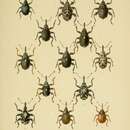Associations
(
Inglês
)
fornecido por BioImages, the virtual fieldguide, UK
Foodplant / feeds on
larva of Ceutorhynchus sulcicollis feeds on Brassicaceae
Foodplant / feeds on
larva of Ceutorhynchus sulcicollis feeds on Sisymbrium officinale
Conservation Status
fornecido por University of Alberta Museums
There is no evidence this species is in need of conservation.
- licença
- cc-by-nc
- direitos autorais
- University of Alberta Museums
Cyclicity
fornecido por University of Alberta Museums
Probably one generation per year. The species has been collected in North America from May to August.
- licença
- cc-by-nc
- direitos autorais
- University of Alberta Museums
Distribution
fornecido por University of Alberta Museums
The species has a Palaearctic distribution (Colonnelli 2004) but is also present across much of North America (Blatchley & Leng 1916).
- licença
- cc-by-nc
- direitos autorais
- University of Alberta Museums
General Description
fornecido por University of Alberta Museums
Acording to the description given by Blatchley & Leng (1916), adults are oblong-oval, steel blue, and have few scales above. There is a faint scutellar spot (grouping of scales at the base of the thorax and elytra) present. The scales are much denser below. The funicle (antennal segments between the scape and the clubbed) is seven segmented. The beak is curved, slender and slightly longer than the thorax. The hind fermora as well as the tarsal claws are both toothed. Length 2.7 – 3.2 mm (Blatchley & Leng 1916).
- licença
- cc-by-nc
- direitos autorais
- University of Alberta Museums
Habitat
fornecido por University of Alberta Museums
This species may be present where brassicaceous herbs can be found.
- licença
- cc-by-nc
- direitos autorais
- University of Alberta Museums
Life Cycle
fornecido por University of Alberta Museums
The larva most likely inhabit the stems, seeds or seed stems of brassicaceous herbs, like other members of their tribe (Blatchley & Leng 1916). The adults feed on several members of the Brassicaceae (Colonnelli 2004).
- licença
- cc-by-nc
- direitos autorais
- University of Alberta Museums
Trophic Strategy
fornecido por University of Alberta Museums
This species has been found on several members of the Brassicaceae as well as Reseda luteola L. (Colonnelli 2004).
- licença
- cc-by-nc
- direitos autorais
- University of Alberta Museums
Ceutorhynchus sulcicollis
(
Português
)
fornecido por wikipedia PT
- licença
- cc-by-sa-3.0
- direitos autorais
- Autores e editores de Wikipedia
Ceutorhynchus sulcicollis: Brief Summary
(
Português
)
fornecido por wikipedia PT
Ceutorhynchus sulcicollis é uma espécie de insetos coleópteros polífagos pertencente à família Curculionidae.
A autoridade científica da espécie é Paykull, tendo sido descrita no ano de 1800.
Trata-se de uma espécie presente no território português.
- licença
- cc-by-sa-3.0
- direitos autorais
- Autores e editores de Wikipedia

